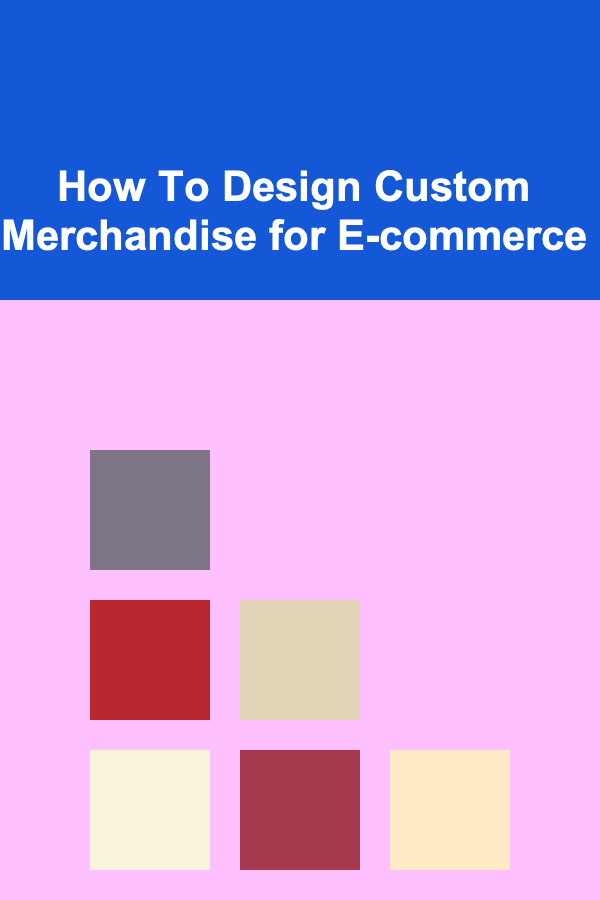
How To Design Custom Merchandise for E-commerce
ebook include PDF & Audio bundle (Micro Guide)
$12.99$5.99
Limited Time Offer! Order within the next:

Designing custom merchandise for e-commerce is an exciting and rewarding venture. It allows businesses to build their brand identity, offer unique products, and cater to a specific audience's preferences. Custom merchandise is not just about selling products; it's about creating a connection with consumers, reflecting your brand's values, and offering something distinctive. Whether you're starting a new online store or enhancing your current e-commerce platform, understanding how to design and create custom merchandise is crucial for long-term success.
This comprehensive guide will walk you through the entire process of designing custom merchandise for e-commerce, from initial concepts to the final sale. By the end of this article, you'll have a solid understanding of how to create compelling and profitable merchandise that resonates with your target audience.
Understanding the Importance of Custom Merchandise in E-commerce
Before diving into the design process, it's essential to understand why custom merchandise holds such importance in e-commerce.
Strengthening Brand Identity
Custom merchandise serves as a direct representation of your brand. It offers a tangible way for customers to connect with your business, making your brand more memorable. Whether it's a custom logo tee, a branded mug, or a unique tote bag, each piece of merchandise can reinforce your brand's values and aesthetic. By offering custom designs that align with your brand, you create an identity that stands out in a crowded marketplace.
Customer Loyalty and Engagement
Custom products allow customers to engage with your brand in a more personal way. People enjoy owning something unique and tailored to their interests. When you create custom merchandise that resonates with your audience, it increases their emotional investment in your brand. This leads to higher customer loyalty and, in turn, encourages repeat purchases and long-term relationships.
Diversifying Revenue Streams
Selling custom merchandise opens up new revenue streams for your e-commerce business. Beyond your core products, custom merchandise can be sold at a premium price due to its uniqueness. Moreover, customers who might not be interested in your primary offerings could still purchase merchandise to support your brand. Custom products can also work as upsells or promotional items, enhancing your average order value.
Finding Your Niche Audience for Custom Merchandise
The first step in designing custom merchandise is identifying your target audience. Different designs appeal to different groups, so it's essential to understand who you're designing for. To effectively cater to your audience, follow these steps:
Define Your Brand's Voice and Values
Your merchandise should reflect your brand's voice and values. For example, a sustainable clothing brand should design eco-friendly custom products that resonate with consumers who care about the environment. On the other hand, a tech company could design sleek, minimalistic items that align with their modern, innovative image.
Conduct Market Research
Market research is crucial for understanding your audience's preferences, habits, and purchasing power. You can gather insights through surveys, social media polls, focus groups, or competitor analysis. By studying your target audience, you can determine what types of merchandise they are most likely to purchase, what colors, designs, and materials appeal to them, and what price range they're comfortable with.
Leverage Existing Customer Data
If you already have an established customer base, you can leverage data from past sales to refine your custom merchandise offerings. Look at popular products, customer reviews, and trends to understand what has been successful. You can also reach out to loyal customers and ask for their feedback on potential merchandise designs.
Conceptualizing Custom Merchandise Designs
Now that you have a clear understanding of your audience, it's time to move on to the design process. Whether you're designing the merchandise yourself or working with a designer, it's essential to have a clear vision for your products.
Brainstorm Ideas Based on Your Brand
Start by brainstorming ideas that align with your brand's core message and values. If your brand is about minimalism, your merchandise should reflect that through clean, simple designs. If you're focused on creativity and fun, go for playful designs that stand out and grab attention. Look for inspiration in your daily life, from nature to current pop culture trends.
Create a Mood Board
A mood board is a great way to visualize the tone and style you want for your custom merchandise. Collect images, colors, fonts, and other design elements that reflect the overall feeling you want your merchandise to convey. This will guide you and any designers you work with to create a cohesive and impactful design.
Keep Design Principles in Mind
When designing custom merchandise, it's essential to focus on the principles of good design. Here are some key aspects to consider:
- Simplicity: Avoid cluttered designs. Your message should be clear and easily understood.
- Color: Use colors that align with your brand identity and appeal to your target audience.
- Legibility: If your design includes text, ensure that it's easy to read from a distance.
- Consistency: Your merchandise should align with the overall aesthetic of your brand and website.
Incorporate Custom Logos or Taglines
Including your brand logo or tagline on your custom merchandise is a great way to promote your business. Make sure that the logo is prominent but not overpowering. The placement and scale should balance the overall design.
Selecting Merchandise Types and Materials
Once you have a design concept, it's time to choose what type of merchandise you want to sell. The choice of product depends on your target audience, budget, and brand image. Here are some popular options to consider:
Apparel
Custom apparel, such as t-shirts, hoodies, and hats, is one of the most popular types of merchandise. People love wearing clothing that represents their favorite brands or personal style. Apparel is versatile and allows for a wide range of designs.
- T-shirts: Custom t-shirts are a classic choice. They're affordable and easy to customize with unique designs.
- Hoodies and Sweatshirts: For colder weather, hoodies and sweatshirts make great custom merchandise. These products offer larger design spaces and appeal to a broad audience.
- Caps and Hats: These are popular accessories and offer opportunities for subtle branding.
Accessories
Custom accessories, such as bags, wallets, and socks, can add variety to your product offerings. They're often considered fashion statements or functional items, making them perfect for brands with a trendy or practical vibe.
- Tote Bags: Custom tote bags are practical and can carry a large design. They're popular for eco-conscious brands.
- Phone Cases: Custom phone cases offer a great way to create merchandise that your customers can carry with them every day.
Home Goods
Custom home goods like mugs, cushions, or posters are perfect for customers looking for branded items to decorate their spaces. These products provide more opportunities for detailed, creative designs.
- Mugs: Custom mugs are always popular, and they're perfect for coffee or tea lovers.
- Posters and Prints: If your designs are visually striking, consider offering custom prints or posters that your audience can hang in their homes.
Sustainability Considerations
Many consumers today are more eco-conscious, and offering sustainable merchandise can set your brand apart. Consider using organic cotton for apparel, recycled materials for accessories, or biodegradable packaging for shipping. Sustainable practices resonate well with audiences who prioritize environmental responsibility.
Choosing a Printing Method
The printing method you choose will depend on the type of merchandise and the complexity of your design. Here are the most common printing methods:
Screen Printing
Screen printing is a popular method for apparel and accessories. It's cost-effective for large batches and creates long-lasting, vibrant designs. However, it's less suitable for intricate or multi-colored designs.
Direct-to-Garment (DTG) Printing
DTG printing is ideal for complex designs with many colors. It's perfect for small batch runs and allows for high-quality prints. However, the process can be more expensive than screen printing, especially for larger quantities.
Heat Transfer Printing
Heat transfer printing involves printing a design onto a transfer paper and then applying it to the merchandise using heat. This method is versatile and works well for small runs and detailed designs.
Embroidery
For apparel such as hats or jackets, embroidery offers a premium, textured look. While more expensive than other methods, it can add a high-quality finish to your merchandise.
Sublimation Printing
Sublimation printing is ideal for polyester fabrics and allows for vibrant, full-color designs. This method works well for creating custom merchandise with intricate, all-over prints.
Setting Up Your E-commerce Platform
Once you've finalized your designs and selected your merchandise types, it's time to set up your e-commerce store. There are several platforms available to help you sell custom merchandise online.
Shopify
Shopify is one of the most popular e-commerce platforms for custom merchandise. It's user-friendly, offers a variety of design and sales tools, and integrates with print-on-demand services to streamline the fulfillment process.
Etsy
Etsy is a great platform for selling custom merchandise, especially for niche or handmade products. It offers access to a large community of customers interested in unique, personalized items.
Print-on-Demand Services
Using print-on-demand services such as Printful, Printify, or Teespring can make the process of creating and fulfilling custom merchandise seamless. These services handle the printing, packaging, and shipping, leaving you with more time to focus on marketing and growing your brand.
Setting Up a Storefront
Ensure your online store is easy to navigate, visually appealing, and optimized for conversions. Use high-quality images of your merchandise, provide detailed descriptions, and ensure your checkout process is simple.
Marketing Your Custom Merchandise
With your products listed on your e-commerce store, it's time to get the word out. Marketing is essential to drive traffic to your store and increase sales.
Social Media Marketing
Social media platforms like Instagram, Facebook, and Pinterest are excellent tools for promoting custom merchandise. Share high-quality photos, behind-the-scenes content, and engage with your audience through comments and messages.
Influencer Collaborations
Collaborating with influencers who align with your brand can help promote your custom merchandise to a larger audience. Choose influencers whose followers match your target demographic for the best results.
Email Marketing
Email marketing is an effective way to keep your audience informed about new merchandise launches, sales, and promotions. Build an email list and send personalized offers to your customers to encourage repeat purchases.
Paid Advertising
Paid advertising through platforms like Google Ads or Facebook Ads can help increase visibility for your custom merchandise. Use targeted ads to reach customers who are most likely to buy your products.
Managing Customer Feedback and Improving Products
Once your merchandise is on the market, it's important to track customer feedback and reviews. Pay attention to what customers like and dislike about your products, and use this information to improve future designs. Engage with your customers to show that you value their input and are committed to delivering high-quality products.
Conclusion
Designing custom merchandise for e-commerce is a powerful way to engage your audience, strengthen your brand, and create new revenue streams. By understanding your target audience, conceptualizing compelling designs, and selecting the right materials and printing methods, you can create custom merchandise that resonates with customers and sets your brand apart. With the right marketing strategies and an effective e-commerce platform, your custom merchandise can thrive in the competitive online marketplace.
Remember, creating custom merchandise is not just about selling products; it's about building connections with your audience and offering them something that's both unique and meaningful. By following the steps outlined in this guide, you'll be well on your way to designing successful custom merchandise that reflects your brand's identity and drives e-commerce growth.

Designing Adaptive Learning Experiences: Innovations and Applications in E-Learning
Read More
How to Leverage Seasonal Demand for Higher Rent
Read More
How to Master Cross-Cultural Communication
Read More
How to Foster Independent Learning Skills
Read More
How to Build a Small Outdoor Shed: A Comprehensive Guide
Read More
10 Essential Weekly Fish Tank Maintenance Tasks
Read MoreOther Products

Designing Adaptive Learning Experiences: Innovations and Applications in E-Learning
Read More
How to Leverage Seasonal Demand for Higher Rent
Read More
How to Master Cross-Cultural Communication
Read More
How to Foster Independent Learning Skills
Read More
How to Build a Small Outdoor Shed: A Comprehensive Guide
Read More